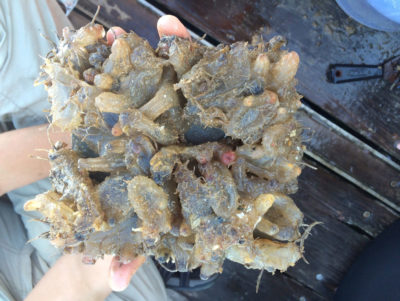The sea squirt Ascidia sydneiensis is one of more than 50 nonnative marine species recently discovered in the Galapagos Islands. Courtesy of Jim Carlton
Dozens of non-native marine species have been discovered in the Galapagos Islands, one of the most protected places on the planet — almost 10 times what scientists previously estimated, according to a new study in the journal Aquatic Invasions. The research highlights the growing toll of the region’s booming tourism industry, which reached a quarter-million visitors last year. Scientists say the alien marine species are primarily being transported to the islands on the hulls of tourist ships.
The islands, located 600 miles west of Ecuador in the Pacific Ocean, were first made famous by Charles Darwin, who visited the archipelago in 1835, a trip that inspired his evolutionary theory of natural selection. The archipelago has been revered for its rich biodiversity ever since. Officials practice strict biosecurity protocols to protect against invasive species, inspecting every boat that enters its waters and sending away any that are carrying non-native species.
The new study, led by scientists at the Smithsonian Environmental Research Center, Williams College, and the Charles Darwin Foundation, documented 53 non-native marine species living in coastal waters around the islands. Previously, scientists knew of just five.
“This increase in alien species is a stunning discovery, especially since only a small fraction of the Galápagos Islands was examined in this initial study,” Greg Ruiz, a marine biologist at the Smithsonian Environmental Research Center and co-author of the new study, said in a statement.
The majority of the invasive species found were sea squirts, marine worms, and moss animals (bryozoans). Scientists say two of the most worrisome species are the bryozoan Amathia verticillate — known for killing seagrasses and ruining pipes and fishing gear — and the date mussel, Leiosolenus aristatus, which bores into corals.
“This discovery resets how we think about what’s natural in the ocean around the Galápagos, and what the impacts may be on these high-value conservation areas,” said lead author James Carlton, a marine biologist at Williams College-Mystic Seaport.



